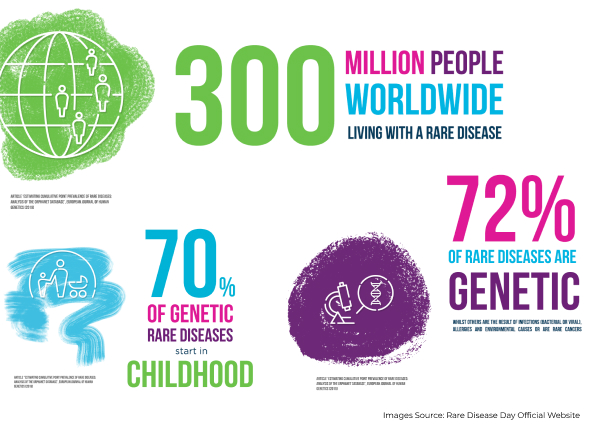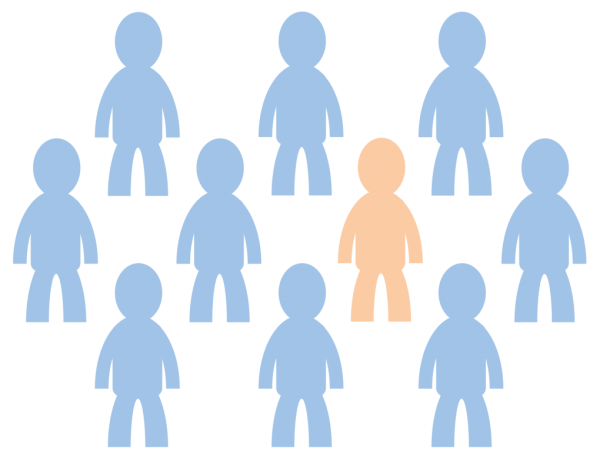All For One - Caring For The Families With A Rare Disease - Part 1
Feb 28, 2023
1632 Views
It was my first day at ADAPT formerly known as the Spastic Society of India. I witnessed the struggles of a teenage boy in a wheelchair attempting to board the city bus. Most city buses did not have ramps or mechanisms to lower the footboard to accommodate the wheelchair. This is a reminder of the importance of inclusion and the barriers to accessing equal opportunities for individuals with disabilities in our society. As a genetic counselor, we often see families with rare diseases who face similar challenges, discrimination, and isolation from mainstream society.
Is rare really rare?
WHO defines a rare disease as a debilitating lifelong disease or disorder with a prevalence of 1 or less, per 1000 population. It is estimated that there are between 6000 and 8000 different rare diseases globally and the known numbers of rare diseases are increasing. While they are individually rare, affecting one in 2000 people or fewer they are collectively quite common. It is conservatively estimated that up to 5.9 percent of the general population lives with a rare disease, equating to an estimated 300 million people worldwide.
Defining the rare
Different countries have defined rare diseases based on their specific requirements and in the context of their population, healthcare system, and resources. One of the studies that investigated how rare diseases were classified found that the main criterion was disease prevalence. In some cases, other criteria included disease severity, whether the disease is life-threatening, whether there are alternative treatment options available, and whether it is heritable.
The Government of India formulated a National Policy for the Treatment of Rare Diseases (NPTRD) in July 2017. However, there were challenges in the implementation of the policy. A limiting factor in its implementation was bringing States on board and lack of clarity on how much government could support in terms of tertiary care.

Challenges in early diagnosis and treatment in India
Early diagnosis of rare diseases is a challenge owing to multiple factors that include a lack of awareness in the general public and medical fraternity. The lack of adequate and accessible screening and diagnostic facilities further causes a delay in diagnosis. Many doctors lack appropriate training and awareness to be able to correctly and timely diagnose and treat these conditions. Commonly offered genetic testing includes tests that can only identify a few diseases. If the test is negative, further testing will be required using next-generation sequencing-based tests, or chromosomal microarray which are applicable, but expensive and time-consuming processes with complex interpretation and counseling requiring expertise in genomics.
Challenges in treatment
Only less than 5% of rare diseases have therapies available to treat them. About 95% of rare diseases have no approved treatment. This means less than 1 in 10 patients receive disease-specific treatment. While drugs are available, they are expensive, placing immense strain on resources. For this reason, rare diseases are also called ‘orphan diseases’ and drugs to treat them are called “orphan drugs”. The development of drugs to treat rare diseases is very expensive apparently to recoup the cost of research and development. As per the rare diseases policy, it is estimated that for a child weighing 10 kg, the annual cost of treatment for some rare diseases, may vary from Rupees 10 lakh to more than 1 crore per year with treatment being lifelong and drug dose and cost, increasing with age and weight.

Bringing them together
We lack epidemiological data on the incidence and prevalence of rare diseases in India which causes poor understanding of the extent of the burden of rare diseases and hinders the development of a definition. This also hampers any effort to build a patient network that can provide peer-to-peer support to affected families. To overcome this, a hospital-based National Registry for Rare Diseases has been initiated by ICMR by involving centers across the country that are involved in the diagnosis and management of Rare Diseases.
- All India Institute of Medical Sciences, New Delhi
- Maulana Azad Medical College, New Delhi
- Sanjay Gandhi PostGraduate Institute of Medical Sciences, Lucknow
- Post Graduate Institute of Medical Education and Research, Chandigarh
- Centre for DNA Fingerprinting & Diagnostics with Nizam’s Institute of Medical Sciences, Hyderabad
- King Edward Medical Hospital, Mumbai
Prevention and reducing burden of rare diseases
The rare disease policy aims at lowering the incidence and prevalence of rare diseases based on an integrated and comprehensive preventive strategy. One of the goals is to raise awareness in the generation regarding premarital, post-marital, pre-conception, and post-conception screening and counseling programmes to reduce the burden of diseases. Another challenge is providing affordable health care to patients with rare diseases within the constraints on resources and competing health care priorities. To facilitate this, the government under the Umbrella Scheme of Rashtriya Arogaya Nidhi is providing financial support up to Rs. 20 lakh for patients needing one-time treatment or relatively low-cost therapy.
To understand the role of genetic counselors in raising awareness about rare diseases, wait for part 2.

